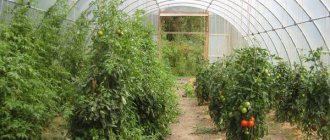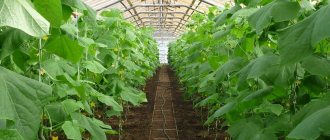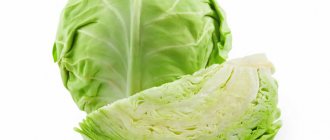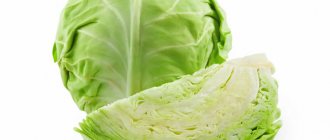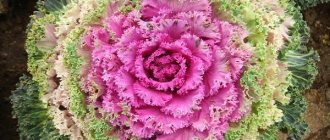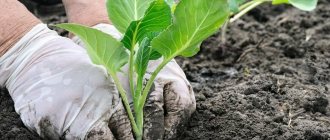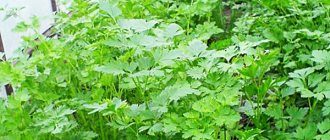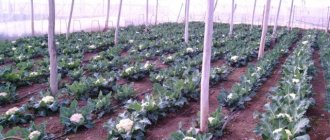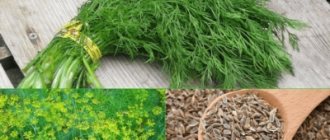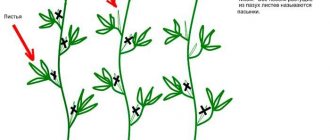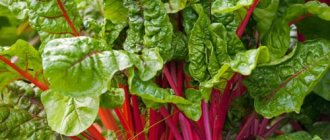It makes sense to grow Chinese cabbage. It is stored for a long time after cutting, contains a lot of useful substances, is tasty, and cooks quickly. If you have a greenhouse at your dacha or country house, then it’s not difficult to provide your family with delicious cabbages.
During the season, which in closed ground lasts from early spring to late autumn, you can harvest 2-3 crops.
Features of culture
The first thing to consider before choosing a planting time is that Chinese cabbage grows well only in short daylight conditions. Due to this feature, it is better to plant the crop in early April or August. To prevent plants from bolting, reflective screens are installed near the plantings on long summer days. Growing Chinese cabbage in a greenhouse will be successful if the daylight hours are shorter than 12 hours.
Despite the fact that seeds germinate at a temperature of +4–+5 °C, the best temperature for the formation of dense heads of cabbage is +16–+22 °C.
Important! Sudden temperature changes should not be allowed in the greenhouse, because Chinese cabbage reacts to them by shooting out arrows.
To sow crops in a greenhouse, select varieties intended for cultivation in a certain season. So in the spring, hybrid plants are planted in the greenhouse on the packaging or in the name of which it is indicated that they are intended for this period. If the time of year does not coincide with the growing period of the selected variety, the cabbage will begin to bolt. To prevent such a course of events, it is better to choose universal varieties for planting, such as the “Chinese Select” and “Mis China” hybrids.
Reviews
Mikhail, Stary Oskol
I trick my Beijing dog so that she doesn’t shoot. I sow the seeds in peat tablets at the beginning of April (from 5 to 10). When the shoots appear, I close them with cardboard boxes after 18-00. After transplanting into the greenhouse, I repeat the closing procedure, covering the ridges with black spunbond.
Nadezhda, Leningrad region
The summer was hot, we had to save the cabbage from flea beetles. I sprayed it with a vigorous solution of black and red pepper. For adhesion I added liquid soap. I won’t say that the effect was 100%, but most of the fleas stuck.
Natalya, Moscow region
Last season I planted a Monaco hybrid. He showed himself excellent. There was no bolting, the heads of cabbage were elastic, large, weighing up to 2 kg. Planted in spring and second half of summer. Both harvests were excellent. The hybrid has 100% germination rate.
Popular varieties
Before you figure out how to grow Chinese cabbage in a greenhouse, you need to choose the right variety. Thanks to the painstaking work of breeders, many varieties of vegetable crops with improved yield and cold resistance have emerged.
The most popular varieties of Chinese cabbage for growing in a greenhouse:
- Monument. With proper care, the Beijing vegetable weighs more than 3 kg;
- Wineglass. Thanks to the delicate structure of the leaves, the heads of cabbage are ideal for fresh consumption. Average weight – 2 kg;
- Stonefly. An early ripening variety of Chinese cabbage, the ripening period of which is less than 40 days. Heads of cabbage weigh 300 g;
- Autumn jade f1. A variety for autumn growing. Head length 50–60 cm, weight – 3 kg;
- September f1. An early ripening variety that is immune to plant diseases and resistant to sudden temperature changes. The weight of vegetable heads is 1.5 kg;
- Marfa. Universal early ripening variety. Less than 40 days pass from emergence to harvest. Cabbage is resistant to bolting and tolerates a lack of sunlight well. Heads of cabbage weigh about 1 kg.
All that remains is to choose the appropriate option.
Landing dates
To obtain high-quality greens and heads of Chinese cabbage, you need a short daylight hours, so the best time to plant the crop is early spring (second decade of April) and the last months of summer. Sowing the crop at the specified time will help to avoid the main problem - bolting of the plant.
Chinese cabbage is a fast-ripening vegetable, but it also has varieties with early (40–55 days), medium (55–60 days) and late (60–80 days) ripening periods. When determining the time of planting a crop, it is necessary to take into account the characteristics of the selected variety: early varieties are preferable for spring sowing, and late varieties are preferable for autumn sowing.
Helpful information! New varieties of Chinese cabbage of Dutch selection are resistant to bolting.
To get an early harvest, you need to opt for the seedling growing method. Seeds for seedlings are planted 25–30 days before the possible date of planting the plant in open ground or a greenhouse, that is, in mid-March for early heads of cabbage or after June 15 for autumn harvest in open ground. For subsequent planting of seedlings in a greenhouse, sowing seeds for seedlings can be organized even earlier - in mid-February, so that the seedlings can be planted in the ground in the second half of March.
With the seedless growing method, the first sowing of seeds can be carried out in well-warmed soil. For the middle zone, this is the end of April or the beginning of May, and the second sowing is organized from the 20th of July to the 10th of August.
Video: about the timing of planting Chinese cabbage
Conditions in the greenhouse
For growing Chinese cabbage, structures made of film or polycarbonate with windows for ventilation are suitable. When choosing a location for installing a greenhouse, it is recommended to take into account the rules of crop rotation. So the best predecessors for Chinese cabbage are tomatoes, onions, cucumbers, zucchini, and carrots. The crop also grows well after beans, soybeans and peas.
To grow “Chinese” cabbage in winter, install a heating system that can maintain a stable temperature in the range of +13–+20 °C. In addition to warmth, Chinese cabbage needs 10 hours of daylight in the autumn-winter period. To fulfill this requirement, phytolamps are installed in the greenhouse. Along with the vitamin-rich Peking cabbage variety, garden crops with similar requirements are also grown: radishes, onions, greens.
When using a method of growing without seedlings, until the crop sprouts appear, the temperature in the greenhouse is kept at +20 °C, and then lowered to 10 °C for a week. The rest of the time the temperature is kept in the range of +15–+20 °C.
Advantages and disadvantages
Among the advantageous features of cultivating Chinese cabbage in greenhouse conditions are:
- The ability to maintain constant conditions necessary for high-quality cultivation: temperature, humidity, average consistency of loose soil.
- Growing vegetables throughout the year with heating in greenhouses.
- Independent regulation of daylight hours.
- Obtaining several harvests (three times harvest) in 1 season.
Gardeners include the following criteria as disadvantages:
- The complexity of the process.
- Increased costs for arrangement and maintenance of greenhouses.
- The need to control the conditions for growing vegetables.
- Mandatory ventilation of premises.
Preparation of planting material
Hand-picked Chinese cabbage seeds or those that have not been processed by the manufacturer are soaked in a 1% solution of potassium permanganate for half an hour. Biological products “Fitosporin-M” and “Baktofit” are also used as a disinfectant liquid for pre-sowing treatment of crop planting material. The solution is prepared in accordance with the instructions supplied with the selected product.
Immediately before planting in pots or in a greenhouse, Chinese cabbage planting material is soaked for 12 hours in a growth stimulator. Popular products are “Epin”, “Zircon”.
How to grow seedlings
Since Chinese cabbage does not like transplants due to its sensitive root system, it is better to sow the seeds of this crop in purchased peat pots or tablets. As a last resort, ordinary pots filled with a light peat substrate to which mineral fertilizer has been added are used as containers for planting plants. To avoid infection of young plants, the soil is treated with a pink solution of potassium permanganate.
Chinese cabbage seedlings are grown as follows:
- 3 seeds are planted in each container to a depth of 1 cm. At a comfortable temperature, seedlings appear within 3 days.
- Among the sprouts, the strongest is left.
- As soon as the seedlings form cotyledon leaves, the container with the seedlings is placed in a lighted place, and the glass is removed.
- The temperature in the room where the container with young plants is located is dropped from +22–23+ to +18 °C.
Water the cabbage as the substrate dries. Since fragile plants are very sensitive to lack of moisture, severe drought should not be allowed. Ideally, the substrate should always be moderately moist.
Chinese cabbage with 3 pairs of leaves, which appear 25–28 days after germination, is planted in a permanent place. In the greenhouse, plants are placed according to a 20x30 cm pattern.
Care
Depending on the presence of a heating system in the greenhouse, Chinese cabbage seeds are planted in the ground in March or April. To disinfect the soil from accumulated pathogens and pests, before picking vegetable seedlings, the bed is spilled with a solution of potassium permanganate or copper sulfate. Planting material is scattered into grooves 1.5 cm deep, covered with soil, and watered. Seed consumption per 1 m2 of area – 2 g.
Growing and caring for Chinese cabbage in a greenhouse includes:
- thinning. As soon as the seedlings become stronger, excess sprouts are removed, leaving only strong specimens. The next time the plantings are thinned out a week after the first manipulation. The interval between the remaining plants is 20–30 cm;
- watering. Since all crops with a shallow root system, Chinese cabbage is very demanding of moisture. Therefore, you need to carefully monitor the condition of the soil and water it on time;
- fertilizing Despite its short growing season, Chinese cabbage does not have time to deplete the soil and does not need to be fertilized. In order for the crop to grow well, the soil is fertilized in the fall. To do this, add 2 tbsp per 1 m2 for digging. potassium sulfate, 1 tbsp. superphosphate. Since the plant prefers to live in a neutral environment, lime is added to the acidic soil. If the soil was not fertilized before winter, it is enriched before planting. As a spring fertilizer, use a mixture of 1 tbsp. ash, 2 tbsp superphosphate, 1 tsp. urea. Drooping plants are fed with a weak organic solution or compost.
Some gardeners, in order to achieve maximum yield from Chinese cabbage, apply organic fertilizers or mineral mixtures with a high nitrogen content to the crop in excess quantities. Despite the rapid growth of plants, this cannot be done, because Chinese cabbage has the ability to accumulate nitrates.
Important! The slightest excess of nitrogen concentration leads to the fact that heads of Chinese cabbage become unfit for consumption.
Sowing seeds in the ground
Spring sowing of seeds directly into the ground can be done in the southern regions. In the average climatic zone, favorable weather for sowing will not arrive until May, and with this period the growing season will fall into long daylight hours, and it will be difficult to avoid bolting of the plant. If a seedless cultivation method is possible, preferably narrow ridges are prepared and seeds are planted in them in the following ways:
- Tape-line, in which wide distances are provided between the tapes (about 50 cm) and narrower ones between the lines (about 30 cm). Sowing of seeds is carried out densely, as thinning will be carried out in the future.
- Group planting in holes, which are made at a distance of 25–30 cm from each other. Place 2-3 seeds in each hole.
Before sowing, it is recommended to mix Chinese cabbage seeds with sand and moisten the soil in the furrows.
It is recommended to bury peking seeds no more than 2 cm. After filling the seeds with soil, the ridges should be pollinated with wood ash. This is an effective way to protect future seedlings from the cruciferous flea beetle. Shoots will appear 4–7 days after sowing.
Recent Entries
Lilac perennials that are beautiful, compact and do not crowd out other plants Why when buying seedlings you should not take the sellers’ word for it and how to determine the age of the plant using 3 signs Tomato seedlings have turned purple or whitish: why the color has changed and how to save the plants
As soon as 1–2 true leaves form on them, the first thinning is carried out. When choosing the strip-line growing method, first leave about 10 cm between the plants, and when closing, carry out a second thinning and leave the plants at a distance of 25–30 cm from each other. When planting in holes, immediately after the true leaves appear, one seedling is left in each hole, and the rest are plucked out.
You need to thin out the sprouts after the second leaf grows, removing the weakest plants from the group
Diseases
Due to improper watering regime, cabbage suffers from fungal diseases. Most often the crop suffers from blackleg, clubroot, powdery mildew and bacteriosis. They fight diseases with folk remedies or industrial fungicides.
Plants affected by black ring spot or mosaic cannot be treated. To prevent the spread of the virus, diseased specimens are pulled out, taken out of the greenhouse and destroyed.
Pest Control
When growing Chinese cabbage in a greenhouse, special attention is paid to pest control. The main enemy of the crop, as well as all other types of cabbage, is the cruciferous flea beetle. You can prevent the colonization of the greenhouse by voracious insects and damage to the presentation of the heads of cabbage by using the following actions:
- Abundant watering. Moisture will repel the flea, which likes to live in dry environments. In addition, water will stimulate plants to actively grow.
- Treatment with tobacco and ash. The row spacing is generously sprinkled with finely ground substances.
- Spraying. Cabbage is treated with an infusion of dandelion roots, tomato tops or wormwood.
- Selecting the right neighbors. Little aggressors are repelled by the smell of cumin, dill, coriander, and mint.
- Shelter. Light agrofibre, lutrasil, and spunbond are laid on top of young plants.
It is possible to treat cabbage, regardless of the variety, with aggressive pesticides only in case of a strong threat to the future harvest. The crop is sprayed with such preparations when there is more than a month left before the expected date for cutting the heads of cabbage.
The second pest of Chinese cabbage is slugs. The reason for the appearance of uninvited guests in the greenhouse is excessive watering. To get rid of aggressors, burdocks or boards are placed between the rows of plants. After some time, the pests hiding under the shelters are collected manually.
Caring for cabbage in the garden
Growing Chinese cabbage requires the gardener to follow certain rules. Newly planted seedlings must be covered with agrofibre or any other non-woven material. This allows:
- protect crops from possible frosts or sudden temperature changes;
- shades plants from the scorching rays of the sun;
- protects the root system of cabbage from rotting during periods of prolonged rain;
- allows you to hide seedlings from pests, cruciferous flea beetles.
Two weeks after planting the seedlings in the garden bed, the area is covered with mulch made from broken straw and peat. There is no need to hill up the crop; a thick layer of organic matter will retain soil moisture and prevent the growth of weeds.
Further measures for caring for cabbage include periodic watering and fertilizing, identifying and protecting vegetables from diseases and pests.
Watering and fertilizing
Chinese cabbage needs regular, abundant watering. It is recommended to moisten the soil once a week using warm water. The liquid should be poured under the root of the plant.
Water contact with leaves causes sunburn.
For better plant development, watering should be done in the morning or in the evening after sunset. In the latter case, it is recommended to use warm water infused throughout the day.
The first fertilizing is applied to the soil two weeks after planting the seedlings. The following solutions can be used for this purpose:
- 10% mullein infusion (1 kilogram per 10 liters of water);
- 5% infusion of bird droppings (500 grams of organic matter per 10 liters of liquid);
- infusion of herbs or nettles.
When fertilizing cabbage with fertilizers, 1 liter of solution is used for each bush. For spring crops, three such feedings are necessary. Plants planted in summer are fed twice during the growing season.
Foliar fertilizing also helps improve the yield of Chinese cabbage. To prepare such a substance, dilute 2 grams of boric acid in a liter of boiled hot water, then bring the volume to 10 liters with cold water. Treatment of crops is carried out in the evening on the leaves.
Harvesting and storing Chinese cabbage
To improve preservation and prevent the development of rot, it is recommended to cut the heads of cabbage in dry weather. The collected fruits are stored in a cool and dry room with a temperature range of 0…+2 degrees. Vegetables are laid out on racks or packed in boxes.
Carry out periodic inspection of the heads of cabbage for dried leaves and rotten areas.
Productivity
Chinese cabbage is an early ripening and high-yielding plant. By observing agrotechnological requirements, it is possible to harvest 600–1000 kg of healthy vegetables from 1 hundred square meters of greenhouse beds. This figure may be lower if you choose the wrong variety and improper care.
Unlike other types of cabbage, the Beijing variety matures in only 45–60 days. Thanks to this early ripening, it is possible to harvest 3 harvests of healthy vegetables in the greenhouse. Peking cabbage is especially popular and therefore expensive in early spring.
Beneficial features
- Improves the functioning of the gastrointestinal tract.
- Of cardio-vascular system.
- Helps normalize blood pressure.
- Strengthens the musculoskeletal system.
- The product contains many vitamins and is suitable for people who lack vitamins and have reduced immunity.
Due to its chemical composition, the vegetable is considered very valuable.
- Contains B vitamins, ascorbic acid, the plant is rich in microelements P, E, K, and has 16 amino acids.
- Cabbage contains a lot of fiber, which helps the body feel full quickly.
The beneficial properties are preserved in pickled and sauerkraut.
Cleaning and storage
Heads of Chinese cabbage are cut off immediately after the number of leaves exceeds 10 and their length reaches 10-15 cm. Spring varieties are ready for harvesting in early July, autumn varieties - in late September-early October. Cabbage, which was grown as a seal, is removed as soon as the main crop begins to actively grow.
Important! It is impossible to keep Chinese cabbage in the garden after ripening, as they begin to bloom.
Heads of vegetable crops are removed from the garden according to the following plan:
- A week before harvesting, stop watering the plants.
- Since the tender leaves wither quickly, harvesting is done early in the morning.
- The heads of cabbage are cut off at the base, leaving a few leaves on the spine. The remainder is fed to domestic animals.
- Spring cabbage is eaten, and autumn cabbage is stored.
To keep the heads of cabbage longer, before storing, they are alternately wrapped in cling film and paper. Provided that the temperature in storage is kept above zero, cabbage can be stored for 4–5 months.
How to plant Chinese cabbage from a stalk
Beijing cabbage is so life-loving that it can please you with a harvest even from its stalk. Moreover, the technology for obtaining such a harvest is very simple. To plant the stalk you need to prepare:
- a deep container that will fit the bottom of a head of Chinese cabbage;
- nutritious, loose soil. This can be a mixture of turf soil with peat or sand in equal proportions;
- a pot for planting, which will be slightly larger in size than the bottom of the head of cabbage;
- dark package;
- sharp knife;
- the head of Chinese cabbage itself.
The bottom of almost any dense head of Chinese cabbage is suitable for growing green leaf mass.
Note! The selected head of cabbage should not show signs of disease: spots, specks and other symptoms of future decay.
The planting process consists of the following steps:
- Separate the bottom of the head of cabbage. The cut piece must be at least 6 cm. This is the starting material for growing greenery and the future head of cabbage.
- Fill the container with water and place the lower part of the stalk in it.
Only the bottom of the stalk should be immersed in water
- Place the vessel in a cool room. High temperatures will inhibit the growth of the stalk. The best place for it is a north-facing window sill or a closed balcony, if it maintains above-zero temperatures.
Literally in a day or two, roots will appear at the bottom of the bottom, followed by green leaves. They can be picked almost immediately and eaten.
Important! A planted stalk quickly produces a flower arrow. It must be removed. If you allow it to develop, the greens will become coarse and tasteless.
To grow greens, the stalk can be left in a container with water. If you want to grow a head of cabbage, then the bottom with the emerging roots is transplanted into a container with soil. This is done carefully, since the roots of Chinese cabbage are tender and brittle. Therefore, the stalk with roots is first placed in a container, and then sprinkled with earth so that only the roots are covered with the soil mixture, and the entire upper part of the stalk is above the ground.
About a week later, after a sufficient number of roots have appeared, the stalk can be planted in the prepared soil mixture
Note! When growing in a pot, it is not always possible to achieve good results. A greater percentage of guarantee of obtaining a head of cabbage is provided by transplanting the stalk into open ground.
The planted plant is not watered for some time and watering is resumed after it begins to produce new green leaves. A growing stalk can have its daylight hours artificially shortened. To do this, it is recommended to cover the plant with a dark bag for 12–13 hours a day.
Important! Provided there is a short daylight hours and the temperature regime is observed (no higher than +18 degrees), after 40–45 days you can get a head of Chinese cabbage. Most likely it will not be very dense, but its weight can reach 1 kg.
You can also plant Chinese cabbage from the stalk to obtain seeds. To do this, the flower shoot that the plant produces is not broken off, but allowed to ripen. After some time, you will be able to collect the seeds and use them for planting in your garden.
The seeds can be allowed to ripen and then sown in open ground or a greenhouse
